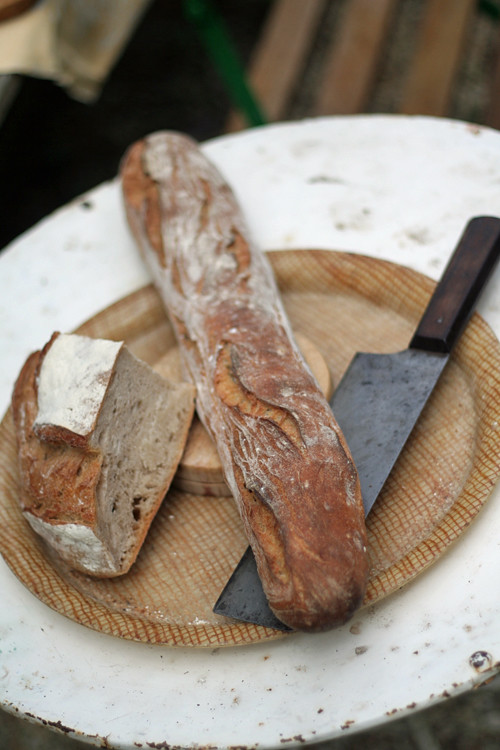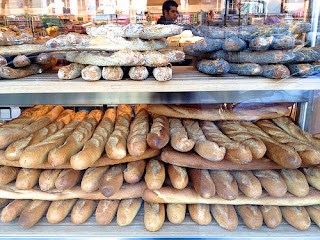Bakery Bread in France
La Boulangerie – The Bakery

The French word for bread is pain, pronounced pan.
Pain Baguette – The most well-known of French breads. A baguette is what most people mean when they ask for French bread. Breakfast in many French homes without a baguette is hardly breakfast; croissants and the sweeter breads are typically saved for the weekend.
Bread in France. How it is different?

Bread may be the most basic of all foods, but, in France choosing bread is also an institution. From my experience the French care more about bread and the types of bread available than any other nation! It is such a valued part of their culture that there is a law regarding bread.
The French bread law
Something that hits all five senses needs protecting, and that’s exactly what the French government did back in 1993 with the Décret Pain. The law states that traditional baguettes have to be made on the premises they’re sold and can only be made with four ingredients: wheat flour, water, salt and yeast. They can’t be frozen at any stage or contain additives or preservatives, which also means they would go stale within 24 hours.
So wish that the United States had this law! We would all be thinner and healthier without all the preservatives. This is a core reason why the French can eat bread every morning and not gain the weight!


The first time I went to France I did a little research on the culture and what foods were served and considered classics. The top item that popped up every time as a food choice favorite, was BREAD. So here are a few tips on how to find good bread…
How to spot a good bakery
- To be called a Boulangerie, a French bakery has to make its bread on the premises. If this prized word doesn’t feature in the name of the bakery or isn’t plastered on the window it could be a plain old dépôt de pain selling industrially-made bread.
- Boulangeries are supposed to display a small yellow and blue sign letting you know that your baker is the real deal, reading: “Votre Boulanger. Un Artisan Authentique“.
- There isn’t a wealth of good bakeries with this sign in France so the appreciated few often have a tell-tale queue snaking outside.
- However, there are a MULTITUDE of wonderful bakeries with and without the noted authenticity sign. One of the best bakeries is located in the 6th arrondissement where we stayed our last visit to Paris.

Boulangerie La Parisienne (48 rue Madame, 6th) won the Best Baguette in Paris for 2016 competition where the winner gets to supply bread to the Palais d’Elysée (the French president’s residence) for a year. This bakery is found in just an average neighborhood, but WOW do not let that fool you – they are masters at baking!

The French even display their bread uniquely to them – the bread baskets are typical French in style. If you would like to own one of these delightful carriers, please visit Aubergine Antiques where these baskets are carried frequently.
This one pictured at Aubergines has found a new use – it is holding stalks of lavender. But, typically it would hold baguettes!
Boulangerie’s also serve other baked goods and may combine the name on the shop as Boulangerie/Patisserie
This is nice if you have a sweet tooth!

Here you can please yourself with treats other than just the delicious flavor and smells of the standard breads – favorites of mine were the croissant and doughnut with chocolate inside.


My son in a french boulangerie enjoying Pain au chocolat!
When you visit France look for an opportunity at breakfast or even better, on a picnic where you may have an excuse to buy three or four different breads of your own choosing. Bon appetite!
SO, with regard to bread items, here are some choices – just so you actually know what you are ordering with a visual attachment when visiting a bakery in France!
Viennoiseries:
The viennoiserie is a unique category of pastry — halfway between bread and French pâtisserie. These items, usually made with laminated dough, include the croissant, pain au chocolat, pain au raisin, and chausson aux pommes.
Le chausson aux pommes (apple pastry):
(chausson – folding a piece of pastry over a filling)

Croissants:
The croissant – very common in America, but taste is superbly different in France.

A good baguette, when you cut into it, should have large, irregular holes. Which not only indicates the proper four ingredients, but also allows the bread to accept butter and jam nicely! The same holds true for the croissant!

Pain au Chocolat (chocolate croissant):
The chocolat is down the middle on the inside – the bread itself is not chocolat flavored!

Pain au Raisin (raisin pastry):


Bread Boards-





Bread, on the table…s’il vous plait
Bread is a necessity to any meal in France, and it is served differently in France than here in America. A tid bit for you if you have never been to France…When served bread at your meal the bread is placed directly on the table, never on a bread plate or on the dinner plate!
If you are served a basket of bread the bread basket is brought over and plunked down, you take a piece and set it on the table next to your plate – this holds true for most bistros and cafés.
Bread is meant to accompany a meal and sop up sauce, it’s not a separate course, so butter isn’t usually served with bread in France. Exceptions are fancy tables and when you get oysters, which comes with rye bread and salted butter.
Thank you for reading our post this week on FRENCH BREAD!
A French Bread recipe for you to try – all fresh and no preservatives! Eat this every morning and evening and I promise you won’t gain weight! HMMMMM……
Enjoy!!
Au Revoir! A La Prochaine!!
- 3 and a quater cups organic all-purpose flour
- 1 teaspoon yeast
- 1½ cups water
- 2 teaspoons salt
- Place the flour in a large mixing bowl, add the yeast and stir to combine.
- Add the water and stir until a dry, clumpy dough forms.
- Cover the bowl with a damp tea towel and let it stand for 20 minutes.
- Sprinkle the salt over the dough and evenly mix it in.
- Knead dough on lightly floured surface for 10-12 minutes til dough firm and smooth.
- Put dough in a plastic container and leave to rise at room temperature for 45 min (rise x 1.5)
- Lightly dust the counter with flour and pat the dough into a rectangle about 6 by 8 inches
- Fold it like a business letter:
- lift the top edge and fold it into the center of the rectangle.
- lift the bottom edge and fold it into the center so it overlaps by an inch.
- flip so the folds are underneath.
- Put the dough back into the container and let it rise for 45 minutes (x 1.5).
- Place a baking stone on the middle oven rack and a cast iron skillet on the lower rack then heat to 500 degrees F.
- Turn the dough onto a floured surface and cut into 3 equal pieces
- Gently pat each piece into a rough rectangle about 5″x7″ and fold it in half.
- Sprinkle with flour and drape with a damp towel for 10 min.
- Shape each piece of dough into a baguette 12 to 14 inches long.
- Place the baguettes seam side down, lightly dust tops with flour and drape with damp tea towel.
- Let the loaves stand at room temperature for 30 to 40 minutes (rise x 1.5).
- Uncover the loaves and score each baguette with a very sharp serrated knife.
- Put the loaves onto the hot baking stone and a cup of ice into the iron skillet.
- Reduce the temperature to 450 degrees F and bake 20 to 25 minutes
